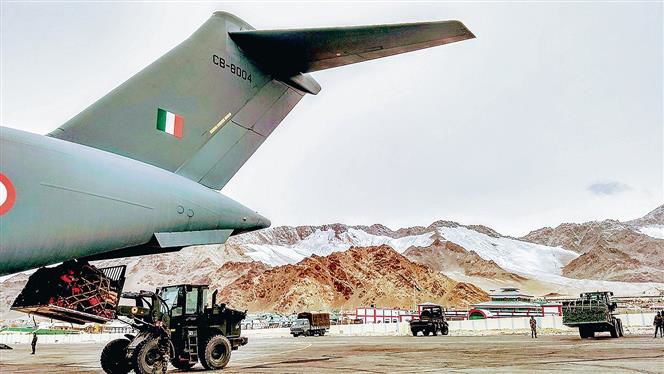
New Delhi, April 13
Heavy-lift helicopters, drones carrying logistics, deployment of all-terrain vehicles and laying of an extensive network of tracks are among the host of measures that have enhanced combat in Siachen glacier, the world’s highest battlefield.
‘Operation Meghdoot’
- ‘Operation Meghdoot’ was launched on April 13, 1984, when the Army and the IAF advanced to the Siachen glacier
- The operation involved airlifting of Army soldiers by the IAF and dropping them on the glacial peaks. IAF helicopters had been operating at Siachen since 1978
As the Army today marks the 40th year of its presence at the strategically significant Siachen glacier, the Leh-based 14 Corps posted on X today that tributes were paid at the Siachen War Memorial in memory of those who guarded the ‘Frozen Frontier’.
‘Operation Meghdoot’ was launched on April 13, 1984, when the Army and the IAF advanced to Siachen glacier. The operation involved airlifting of Army soldiers by the IAF and dropping them on the glacial peaks. IAF helicopters had been operating at Siachen since 1978.
Till 1984, Pakistan had been granting permissions for foreign mountaineering expeditions in Siachen. It all happened due to the demarcation of the Line of Control (LoC) with Pakistan after the 1971 war. The LoC documents beyond point NJ 9842, the line shall run thence northwards. India and Pakistan have varying perception of what is northwards.
The IAF today said “tactical and strategic airlifters An-12s, An-32s and IL-76s transported stores and troops and airdropped supplies to high-altitude airfields”.
As of today, nearly all aircraft of the IAF, including Rafale, Su-30MKI, Chinook, Apache, Advanced Light Helicopter (ALH) Mk III & Mk IV, Light Combat Helicopter (LCH) Prachand, MiG-29, Mirage-2000, C-17, C-130 J, IL-76 and An-32, operate in support of Operation Meghdoot.
An official said, “The induction of heavy-lift helicopters and logistic drones has vastly improved the supply of essentials to the personnel deployed in posts that remain cut off especially in winters.”
Troop comfort has improved due to availability of special clothing, mountaineering equipment and advanced rations. Fresh ration and vegetables are now a reality for forward posts, thanks to new logistic initiatives.
There has been an improvement in mobile and data connectivity in the region. The introduction of the VSAT technology has revolutionised communication at the glacier, providing the troops with data and Internet connectivity. The VSAT or very small aperture terminal is a data-transmission technology.
The Army has also been focusing on boosting the medical infrastructure in Siachen. The Indian Space Research Organisation has established telemedicine nodes that provide critical medical support not only to the troops but also to the local populace and tourists in the Nubra valley.
